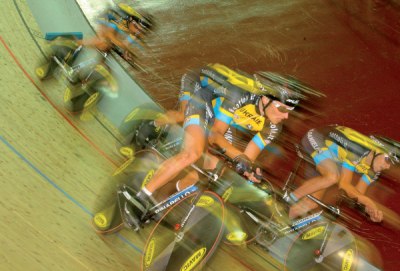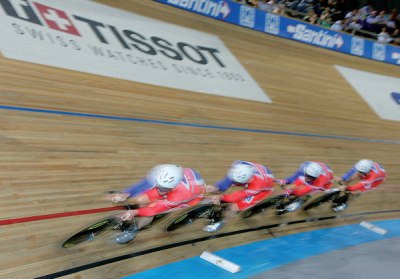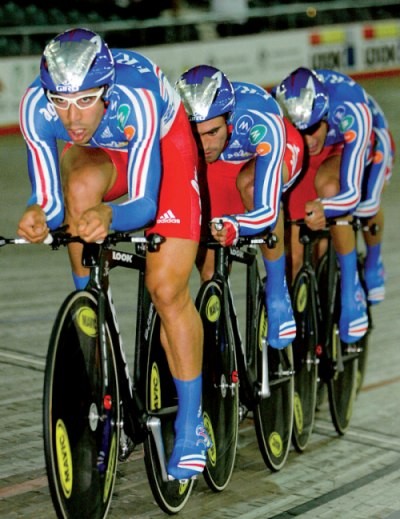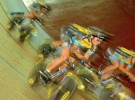bThe team pursuit is one of the most finely drilled and intense of all cycling disciplines. We spoke to former World and Olympic Champion Graeme Brown about what it takes to win it.
Cycling can be described as both an individual and a team sport. But when it comes to the team pursuit there is no room for individuality, this is a pure out and out team effort. There are often superb individual pursuit specialists, but they don’t necessarily make for good team pursuit riders. These are usually strong, well versed riders with great strength and speed. For many years the Australian team have either been at or near the top in the discipline. When you watch a well trained and disciplined team in action, it’s amazing. Not a single beat is missed. Everything is slick and precise, silky smooth. The speed is constant and the changes so close that they hardly break the revolving chain. Team pursuit showdowns are often won and lost by a fraction of a second, which is why perfect preparation is vital. We spoke to long time Australian team pursuit squad member Graeme Brown about the essentials required to win a team pursuit race.
Basic Preparation
 “Depending on the actual competition (Worlds/Olympics or a World Cup and its level of importance), I prepare differently, as I also have my other racing and training commitments to consider. “For a major meeting I would do a lot of very specific ergo and O2 work on my own, before I go to the track camp. With simple road training and racing you get out of the habit of things, including riding in an aero position. This pre training is important as it does away with wasting time in a transition period simply getting used to the basics of high cadence and short intensity work. This way I get here and I can settle back into the rhythm a lot more easily and concentrate on just training!
“Depending on the actual competition (Worlds/Olympics or a World Cup and its level of importance), I prepare differently, as I also have my other racing and training commitments to consider. “For a major meeting I would do a lot of very specific ergo and O2 work on my own, before I go to the track camp. With simple road training and racing you get out of the habit of things, including riding in an aero position. This pre training is important as it does away with wasting time in a transition period simply getting used to the basics of high cadence and short intensity work. This way I get here and I can settle back into the rhythm a lot more easily and concentrate on just training!When we are in camp we do a lot of technique work that is high cadence and heart rate based.This is designed to fine tune the base road fitness that the riders have and get us back into the high intensity level we need on the track.”
All for One
“Well, the basic element of a team pursuit is that it is just that; a TEAM pursuit. So you need to ride together as one big motor. So the more in sync you all are the better your motor will run. It’s very important to be compatible riders, of similar styles and abilities. Without this it’s hard to mesh together well. Spending time together, both on and off the bike and learning to work together as one, irons out potential differences. The better the riders work together, the faster they will go. This work is obviously best done on the track, but it helps to work on the road when time and facilities are not available – even add sessions into group training rides.”

Who’s who?
“Each member of the team has, more or less, got a specific role to play within the team and the event. So the coach will see who fits best in the process and arrange the team like so. This is very important and best done by an experienced observer and coach, who can see more clearly. “Firstly you have the starter, usually someone with a good kick and power. He’s the rider who needs to get the team off the line fast, but not too fast or the other three guys might blow up. Then comes second wheel, this is a very demanding position and needs a very strong person to lift the pace. Then third wheel finishes it off. Last, but not least, is fourth wheel, or the ‘dining cart’ position. Basically this person is there to pull the big turns when required.”
Pacing
.jpg)
“Pacing and judging the pace is what the coach is for at the race. He will ‘walk the line’, the start line beside the track, to a pre determined time schedule, which you should always have in mind. This you should know from previous events and training sessions. But it can be adapted to the track, conditions and fitness levels. Schedules are very important. When the coach is up on the line a step it means you’re up a second and the same goes for when he’s down on the line. There is no time to look at clocks and meters, so this indication is the best way to judge your pace. In the final the coach will generally ‘walk the line’ for the first half of the race, based on the time schedule and then continue to walk the line for the second half.
But that corresponds to how far up or down you are on the team on the other side of the track. This is generally only used for finals when time is not the most important thing. It’s best to rely on the coach for this, and not to get distracted by looking at your opponents.”
Communication
“During the event there is very minimal communication between the team riders. Two words only are used in the race and they are ‘up’, meaning get out of the way you’re going too slow. This is always the decision of the rider in second position. Then there is ‘three’, meaning that I have blown and I am not with the team anymore. This is normally a very important and loud call and is passed on through the team so everyone knows. Otherwise the rider swinging off the front could miss getting back in to position, and the whole thing could fall apart.”

Swinging Out
“The ‘swing’ and sitting close to the wheel in front are two of the most important factors of a team pursuit, as they allow you to rest and recover better and then to pull harder on the front (in theory). If after your turn you can do a nice, high swing and land perfectly back on the wheel, then you can start to recover straight away. If you miss it and have to chase a little bit, your turn becomes longer and your recovery time is shortened. Some people sit really close to the wheel, others prefer not to, this depends on the rider, but the crucial thing is to hold that wheel and get back on to it as soon and as effortlessly as you can after a turn.”
When Things Fall Apart
“Basically there is no rule or plan if it is splitting up. Team pursuits are sometimes won and lost by milliseconds and if you’re splitting up then the game is almost over. In some cases some quick thinking can save the day.” It’s always the third rider whose time counts, so you can never afford to lose more than one rider. If it’s early in the game and a rider just misses that last wheel or is struggling, you may have to ease slightly and then let him miss turns in order to keep things together. But at the highest level you can’t afford to lose a rider until the very last minute and even then you must remember that the team is pretty evenly matched and you may be about to lose another rider.”

